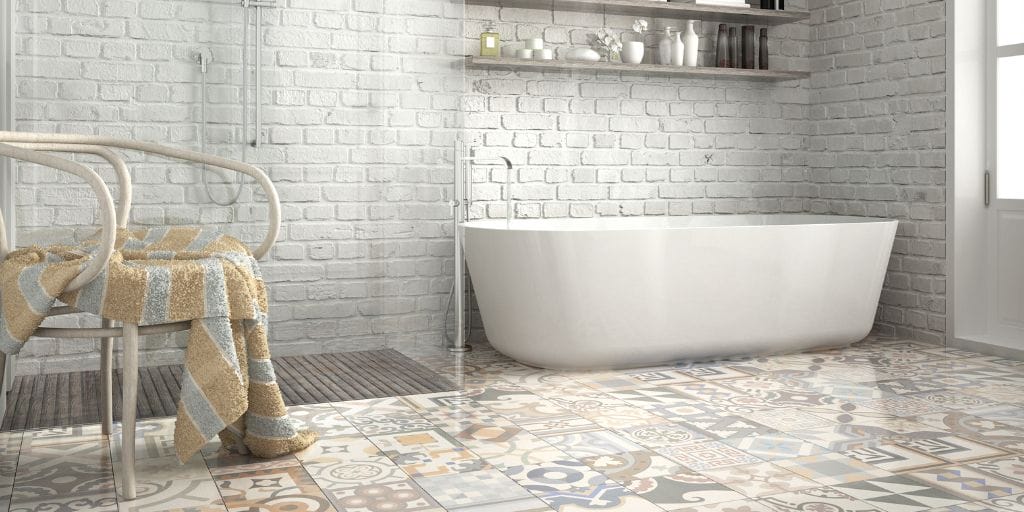From writing your emails to planning your weekly meals, Artificial intelligence is popping up here, there and everywhere! And now it’s even edging its way into home design. You might have seen ads for AI bathroom design tools that promise to generate layouts, mood boards, and full 3D renders in seconds. But before you let a digital assistant loose on your dream bathroom, it’s worth knowing what AI can (and can’t) do.
AI as an inspiration tool
There’s no denying that AI is absolutely brilliant at getting your creative juices flowing. Feed it a few prompts like your room size, preferred style, and maybe a colour palette, and it can instantly produce a range of designs that look straight out of a glossy magazine. Some apps even let you upload photos of your current space to see virtual makeovers in seconds.
These tools are fantastic for helping you define your tastes. For example, if you’re unsure whether you prefer modern minimalism or rustic farmhouse vibes, AI can show you both side by side. Tools like ChatGPT and design-focused apps can help you brainstorm tile patterns, lighting concepts, or space-saving tricks you might not have considered.
In short, AI is great for the idea phase. It helps you visualise possibilities quickly and gives you language to discuss your preferences when you meet with a real designer or installer.
So where does AI fall short in bathroom design?
The biggest issue with getting AI to design your space is that AI doesn’t know what’s behind your walls. And we don’t mean that in a scary sense (although cutting into a water pipe is our idea of a horror movie), we mean that it doesn’t understand plumbing runs, joist directions, or where your wiring and pipes are hiding.
It won’t know if that sleek wall-hung toilet you love needs reinforcement or if moving the shower means cutting into a supporting beam. Nor will it ask about your home’s age, construction type, or whether your bathroom is north- or south-facing. These are all details that massively affect layout, ventilation, and lighting.
AI also doesn’t know about building regulations, electrical safety standards, or local codes. What might look perfect on a screen could be illegal or unsafe in practice. And it definitely won’t consider practicalities like cleaning, access panels, or how you’ll service your boiler if it’s boxed in by a vanity unit.
So while AI can generate beautiful mock-ups, they’re best for loose inspiration only and shouldn’t be used to make actual decisions without first consulting a professional.
Design vs Usability
Just because a layout looks good on an AI plan doesn’t mean it’s going to work in real life.
You know that moment when you finally see your new bathroom, and it looks amazing… until you realise you have to shuffle sideways past the toilet to get to the shower? Or the cabinet doors can’t open properly because they hit the radiator? Yeah, AI doesn’t “feel” space the way people do. It doesn’t get how we move around or what actually feels comfortable.
A good bathroom designer spots those things straight away. They’ll know that a walk-in shower with no lip might look great in a render but will leave puddles everywhere. Or that putting a mirror opposite a window might sound clever until the morning sun hits you right in the eyes.
Design isn’t just about what fits into the space, it’s about how the space works when you actually use it. And that’s the part AI still hasn’t quite figured out yet!
Why experience matters in bathroom design
Decades of hands-on experience teach designers things AI simply doesn’t ask about. Professionals think about how water behaves, how light changes through the day, and how real people move through a space. They’ll ask whether your household has kids, how tall everyone is, or whether you need extra storage for cleaning products. These little details shape a design more than you might think.
Even aesthetic choices can backfire without that experience. Take the all-black porcelain trend. It’s absolutely striking in photos, but in hard water areas it can quickly become a cleaning nightmare, showing every streak and water spot. AI doesn’t know your postcode or your water quality, so it can’t warn you about that.
Or consider the growing popularity of walk-in showers. AI tools might suggest one for its stylish, open look, but many homeowners are caught off guard when they discover how much splash can escape without the right gradient or lip. These are lessons learned through years of problem-solving in real bathrooms, not something a prompt can teach.
The risk of biased answers
Another thing to keep in mind is that AI is designed to be helpful, sometimes too helpful! When you ask it to design a “perfect modern bathroom,” it’ll do exactly that, often giving you an overly positive, idealised version of what’s possible. It “wants to please” and may downplay potential problems to match your enthusiasm.
If you only prompt AI in a positive way (“show me a stunning spa-style ensuite”), you’ll get glamorous renders that gloss over the realities of plumbing, condensation, or cleaning. Try prompting it the other way too like “show me potential problems with a spa-style ensuite in a small space.” You’ll get a much more balanced picture.
So, can ai really design your bathroom?
Not entirely. AI is a brilliant creative partner, it can inspire you, speed up early planning, and help you articulate what you want. But it’s no substitute for the insight of a skilled designer or the practical know-how of an experienced installer.
Bathrooms are complex spaces. They demand an understanding of water, electrics, structure, and usability that only comes with real-world experience.
Looking for an experienced bathroom designer and fitter? Come have a chat with our friendly team, we have decades of experience creating dream bathrooms.

